Management Accounting: Cost Allocation Methods Analysis - Beztec Ltd
VerifiedAdded on 2023/06/06
|15
|2625
|402
Report
AI Summary
This report provides an analysis of cost allocation methods, focusing on Beztec Limited. It discusses the traditional costing system and its disadvantages, contrasting it with Activity Based Costing (ABC). The importance of choosing the correct costing method for effective decision-making is emphasized, along with an analysis of Beztec Limited's cost data. Recommendations are provided for Sue Smith, the accountant, regarding the adoption of ABC. The report also analyzes the gross profit margin under both costing systems and addresses the treatment of over-recovery and under-recovery of costs, concluding with overall recommendations for the company. The analysis highlights the significant impact of costing methods on profitability and strategic decisions.
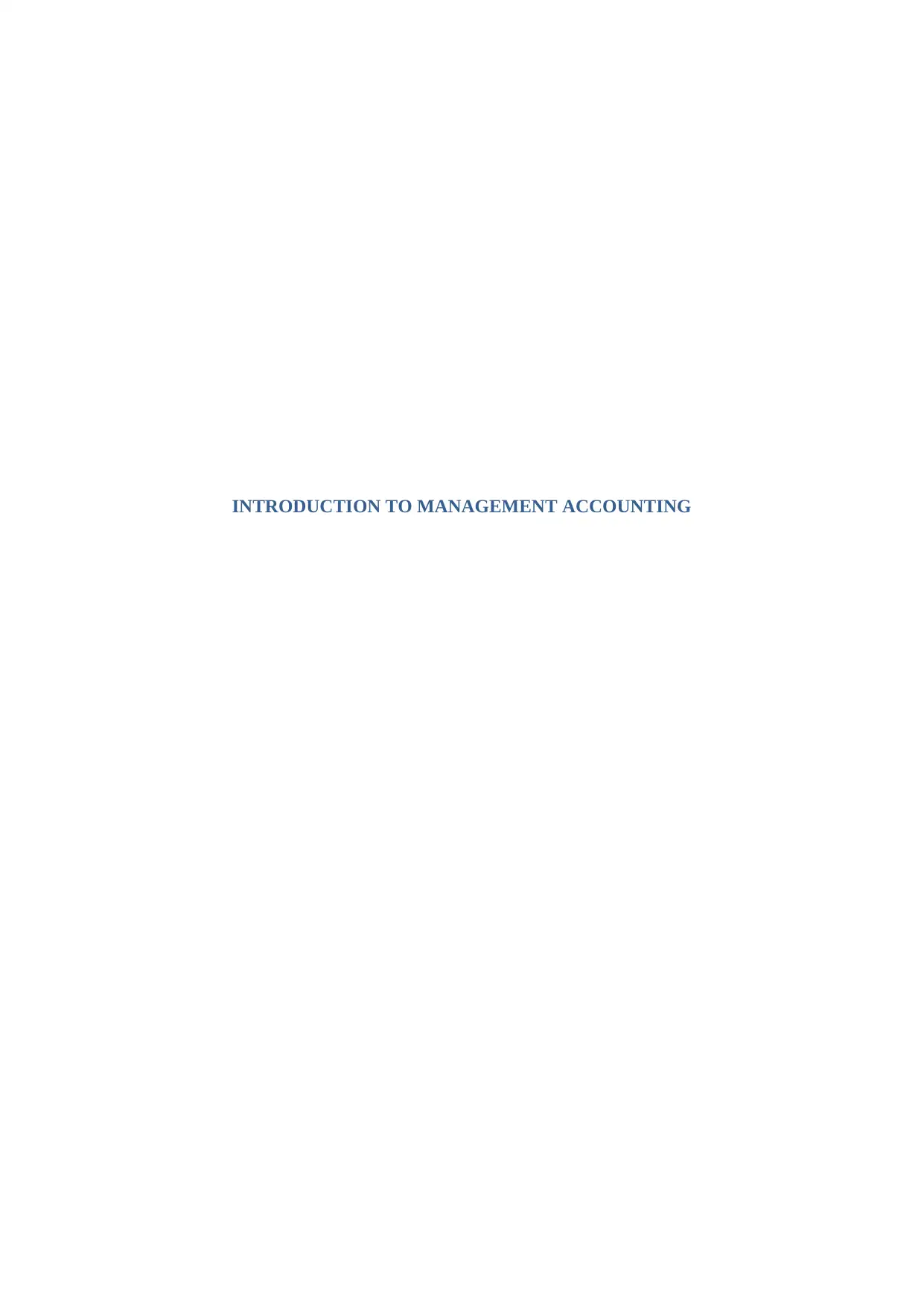
INTRODUCTION TO MANAGEMENT ACCOUNTING
Paraphrase This Document
Need a fresh take? Get an instant paraphrase of this document with our AI Paraphraser
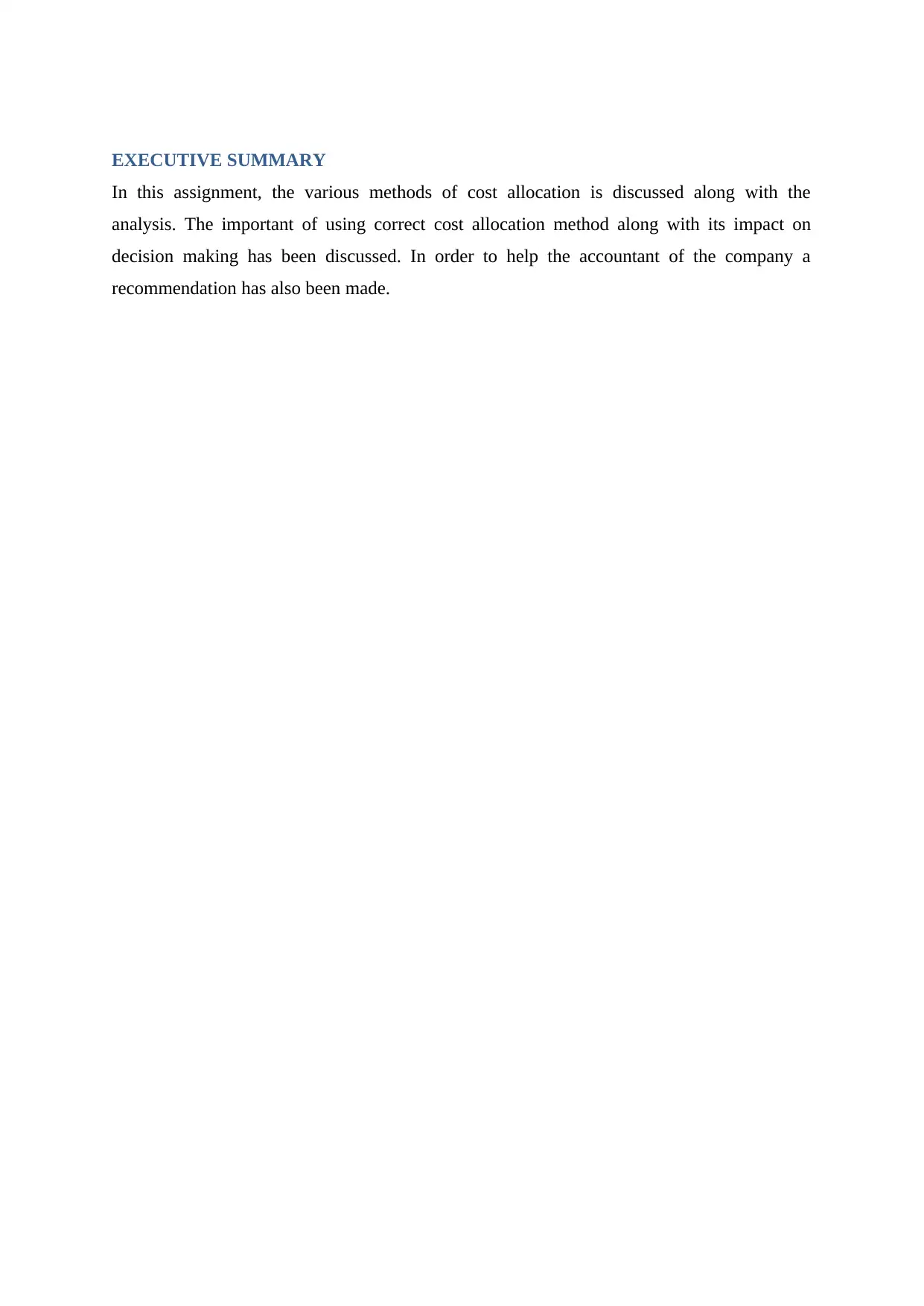
EXECUTIVE SUMMARY
In this assignment, the various methods of cost allocation is discussed along with the
analysis. The important of using correct cost allocation method along with its impact on
decision making has been discussed. In order to help the accountant of the company a
recommendation has also been made.
In this assignment, the various methods of cost allocation is discussed along with the
analysis. The important of using correct cost allocation method along with its impact on
decision making has been discussed. In order to help the accountant of the company a
recommendation has also been made.
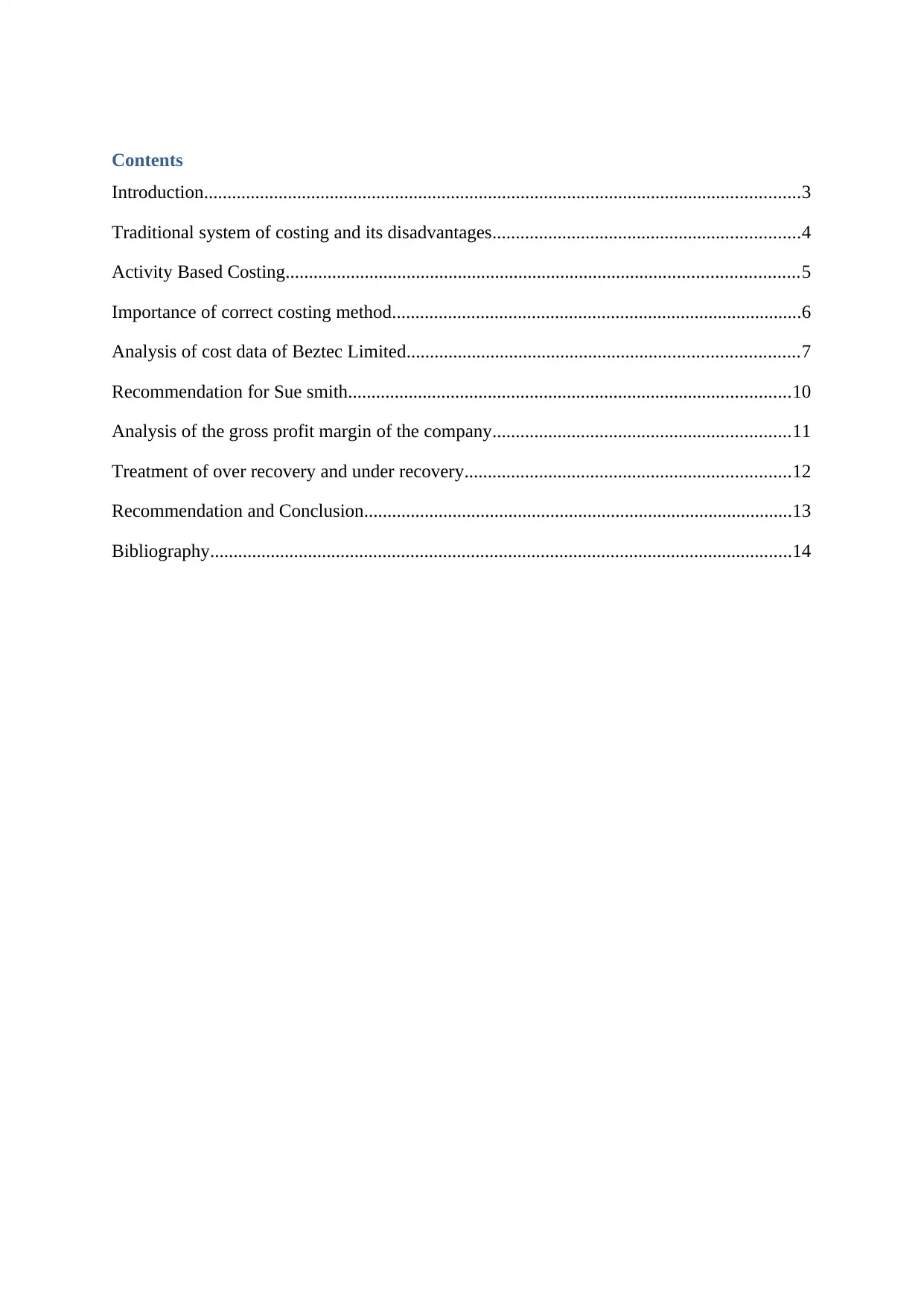
Contents
Introduction................................................................................................................................3
Traditional system of costing and its disadvantages..................................................................4
Activity Based Costing..............................................................................................................5
Importance of correct costing method........................................................................................6
Analysis of cost data of Beztec Limited....................................................................................7
Recommendation for Sue smith...............................................................................................10
Analysis of the gross profit margin of the company................................................................11
Treatment of over recovery and under recovery......................................................................12
Recommendation and Conclusion............................................................................................13
Bibliography.............................................................................................................................14
Introduction................................................................................................................................3
Traditional system of costing and its disadvantages..................................................................4
Activity Based Costing..............................................................................................................5
Importance of correct costing method........................................................................................6
Analysis of cost data of Beztec Limited....................................................................................7
Recommendation for Sue smith...............................................................................................10
Analysis of the gross profit margin of the company................................................................11
Treatment of over recovery and under recovery......................................................................12
Recommendation and Conclusion............................................................................................13
Bibliography.............................................................................................................................14
⊘ This is a preview!⊘
Do you want full access?
Subscribe today to unlock all pages.

Trusted by 1+ million students worldwide
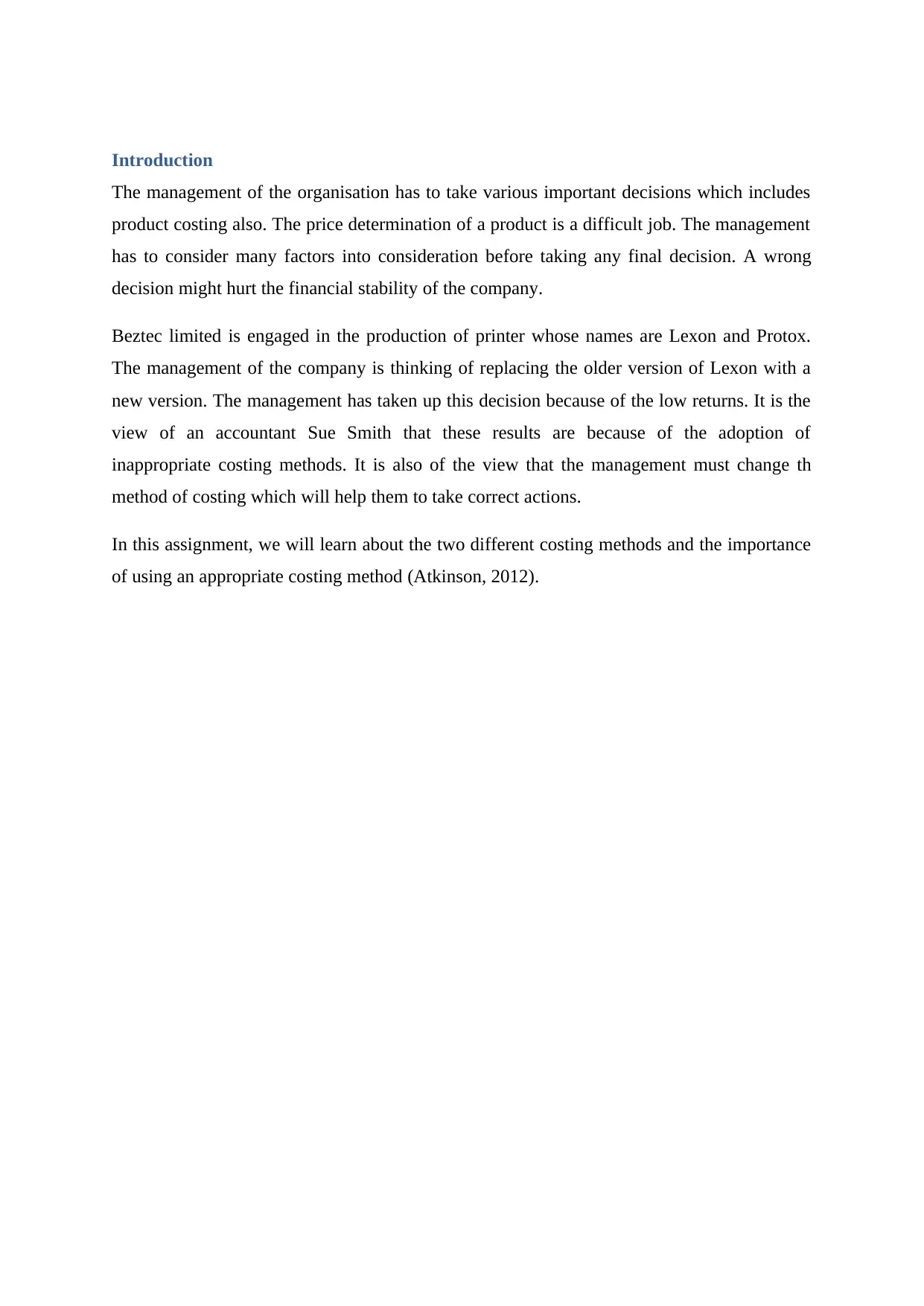
Introduction
The management of the organisation has to take various important decisions which includes
product costing also. The price determination of a product is a difficult job. The management
has to consider many factors into consideration before taking any final decision. A wrong
decision might hurt the financial stability of the company.
Beztec limited is engaged in the production of printer whose names are Lexon and Protox.
The management of the company is thinking of replacing the older version of Lexon with a
new version. The management has taken up this decision because of the low returns. It is the
view of an accountant Sue Smith that these results are because of the adoption of
inappropriate costing methods. It is also of the view that the management must change th
method of costing which will help them to take correct actions.
In this assignment, we will learn about the two different costing methods and the importance
of using an appropriate costing method (Atkinson, 2012).
The management of the organisation has to take various important decisions which includes
product costing also. The price determination of a product is a difficult job. The management
has to consider many factors into consideration before taking any final decision. A wrong
decision might hurt the financial stability of the company.
Beztec limited is engaged in the production of printer whose names are Lexon and Protox.
The management of the company is thinking of replacing the older version of Lexon with a
new version. The management has taken up this decision because of the low returns. It is the
view of an accountant Sue Smith that these results are because of the adoption of
inappropriate costing methods. It is also of the view that the management must change th
method of costing which will help them to take correct actions.
In this assignment, we will learn about the two different costing methods and the importance
of using an appropriate costing method (Atkinson, 2012).
Paraphrase This Document
Need a fresh take? Get an instant paraphrase of this document with our AI Paraphraser
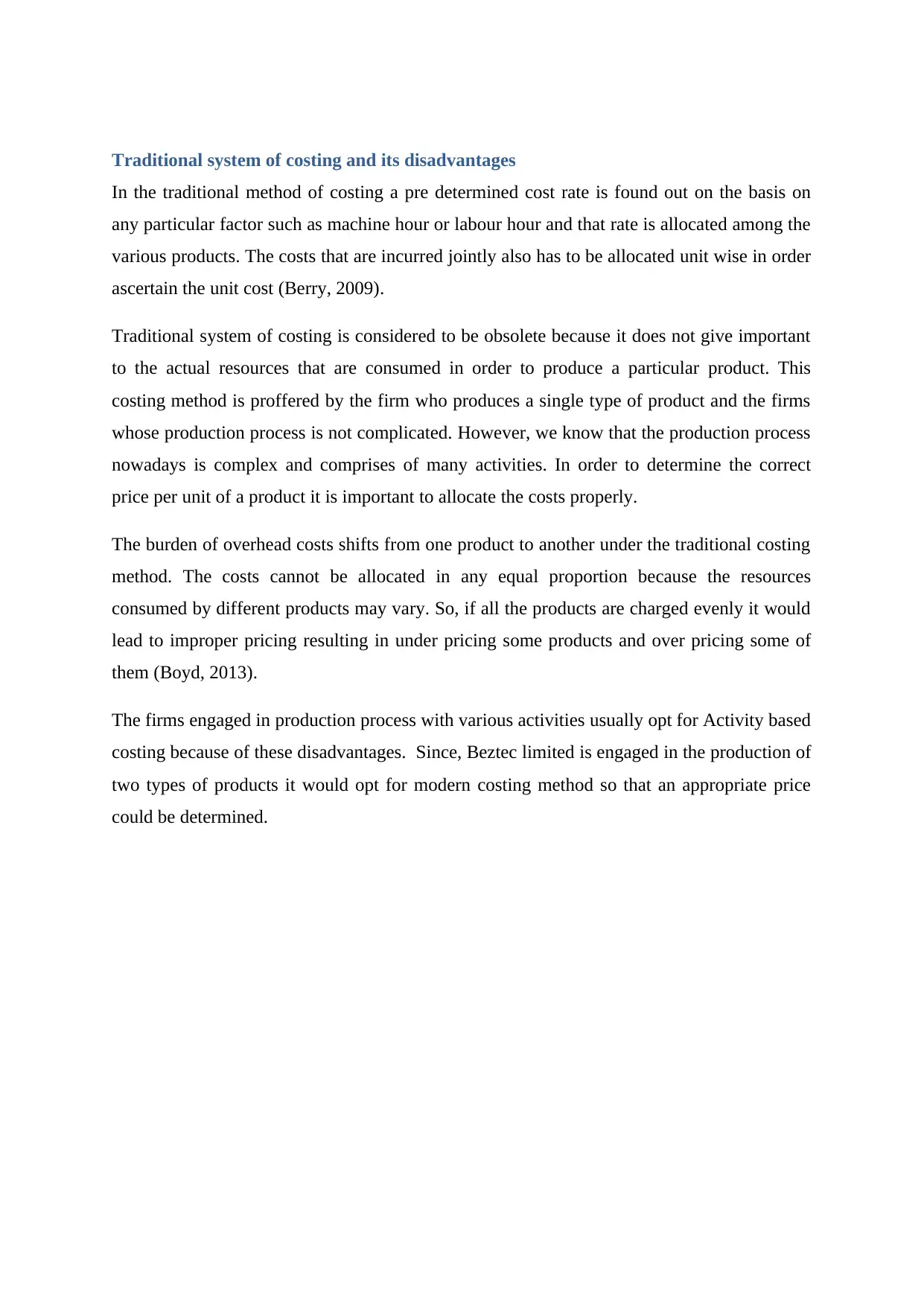
Traditional system of costing and its disadvantages
In the traditional method of costing a pre determined cost rate is found out on the basis on
any particular factor such as machine hour or labour hour and that rate is allocated among the
various products. The costs that are incurred jointly also has to be allocated unit wise in order
ascertain the unit cost (Berry, 2009).
Traditional system of costing is considered to be obsolete because it does not give important
to the actual resources that are consumed in order to produce a particular product. This
costing method is proffered by the firm who produces a single type of product and the firms
whose production process is not complicated. However, we know that the production process
nowadays is complex and comprises of many activities. In order to determine the correct
price per unit of a product it is important to allocate the costs properly.
The burden of overhead costs shifts from one product to another under the traditional costing
method. The costs cannot be allocated in any equal proportion because the resources
consumed by different products may vary. So, if all the products are charged evenly it would
lead to improper pricing resulting in under pricing some products and over pricing some of
them (Boyd, 2013).
The firms engaged in production process with various activities usually opt for Activity based
costing because of these disadvantages. Since, Beztec limited is engaged in the production of
two types of products it would opt for modern costing method so that an appropriate price
could be determined.
In the traditional method of costing a pre determined cost rate is found out on the basis on
any particular factor such as machine hour or labour hour and that rate is allocated among the
various products. The costs that are incurred jointly also has to be allocated unit wise in order
ascertain the unit cost (Berry, 2009).
Traditional system of costing is considered to be obsolete because it does not give important
to the actual resources that are consumed in order to produce a particular product. This
costing method is proffered by the firm who produces a single type of product and the firms
whose production process is not complicated. However, we know that the production process
nowadays is complex and comprises of many activities. In order to determine the correct
price per unit of a product it is important to allocate the costs properly.
The burden of overhead costs shifts from one product to another under the traditional costing
method. The costs cannot be allocated in any equal proportion because the resources
consumed by different products may vary. So, if all the products are charged evenly it would
lead to improper pricing resulting in under pricing some products and over pricing some of
them (Boyd, 2013).
The firms engaged in production process with various activities usually opt for Activity based
costing because of these disadvantages. Since, Beztec limited is engaged in the production of
two types of products it would opt for modern costing method so that an appropriate price
could be determined.
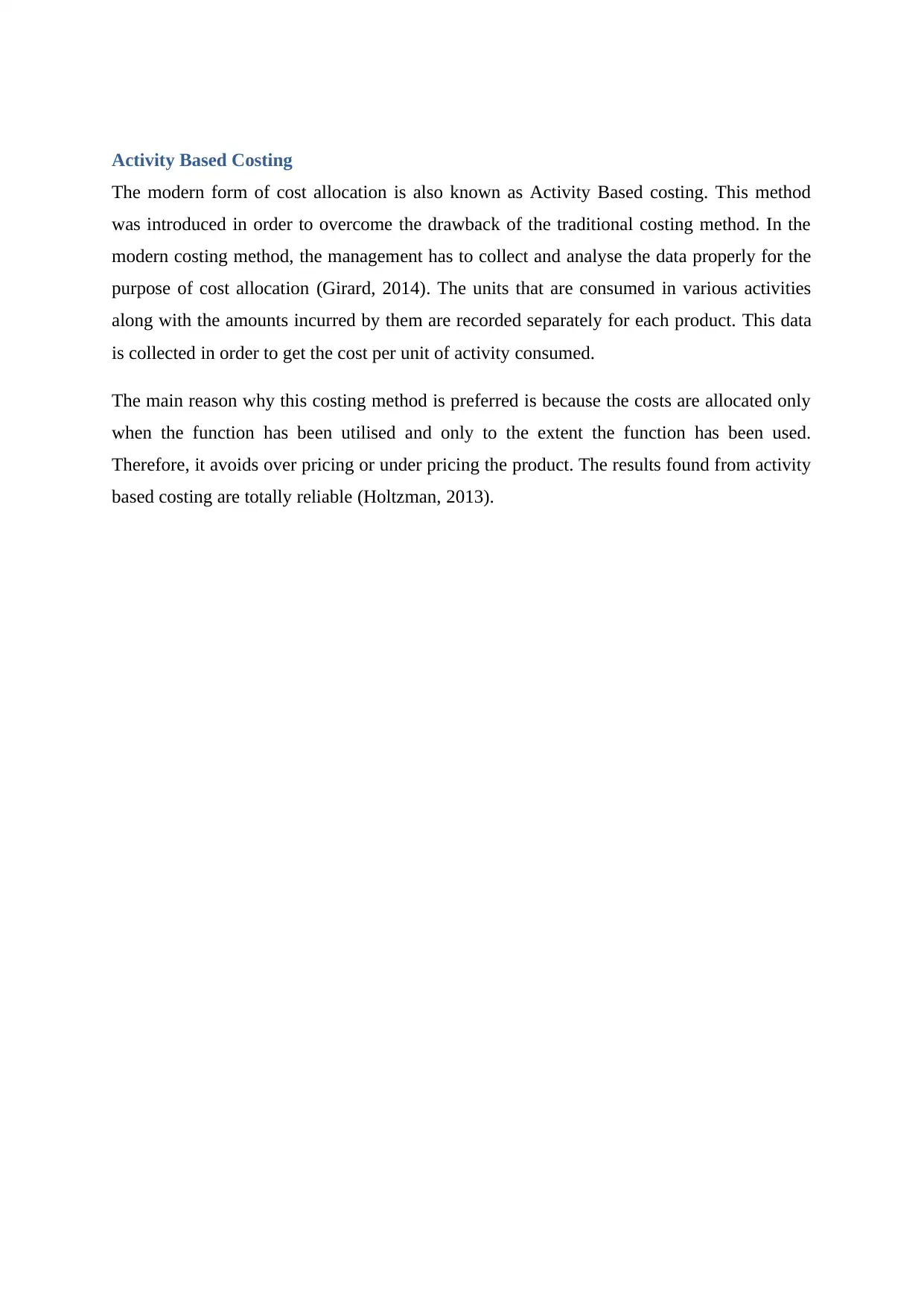
Activity Based Costing
The modern form of cost allocation is also known as Activity Based costing. This method
was introduced in order to overcome the drawback of the traditional costing method. In the
modern costing method, the management has to collect and analyse the data properly for the
purpose of cost allocation (Girard, 2014). The units that are consumed in various activities
along with the amounts incurred by them are recorded separately for each product. This data
is collected in order to get the cost per unit of activity consumed.
The main reason why this costing method is preferred is because the costs are allocated only
when the function has been utilised and only to the extent the function has been used.
Therefore, it avoids over pricing or under pricing the product. The results found from activity
based costing are totally reliable (Holtzman, 2013).
The modern form of cost allocation is also known as Activity Based costing. This method
was introduced in order to overcome the drawback of the traditional costing method. In the
modern costing method, the management has to collect and analyse the data properly for the
purpose of cost allocation (Girard, 2014). The units that are consumed in various activities
along with the amounts incurred by them are recorded separately for each product. This data
is collected in order to get the cost per unit of activity consumed.
The main reason why this costing method is preferred is because the costs are allocated only
when the function has been utilised and only to the extent the function has been used.
Therefore, it avoids over pricing or under pricing the product. The results found from activity
based costing are totally reliable (Holtzman, 2013).
⊘ This is a preview!⊘
Do you want full access?
Subscribe today to unlock all pages.

Trusted by 1+ million students worldwide
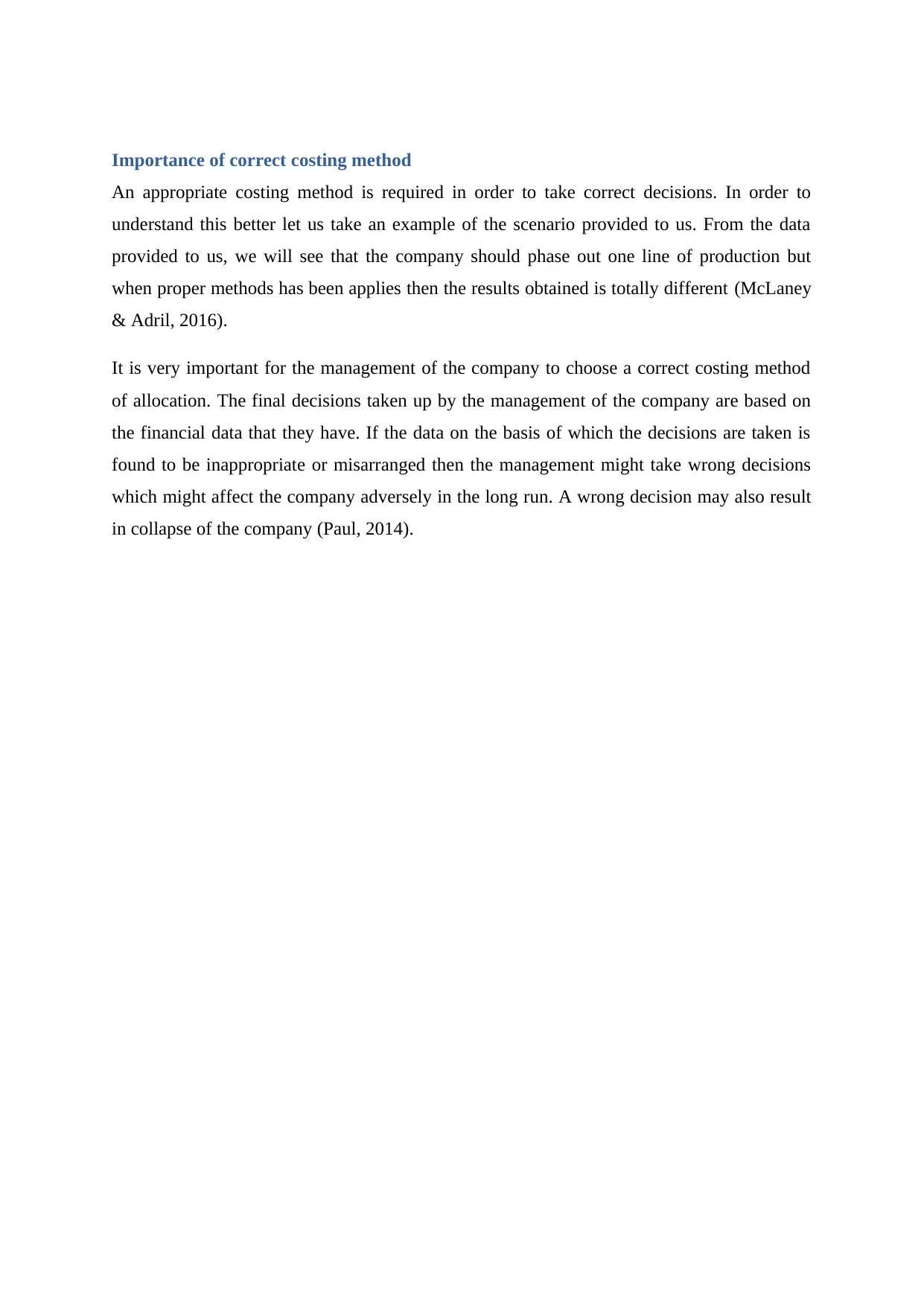
Importance of correct costing method
An appropriate costing method is required in order to take correct decisions. In order to
understand this better let us take an example of the scenario provided to us. From the data
provided to us, we will see that the company should phase out one line of production but
when proper methods has been applies then the results obtained is totally different (McLaney
& Adril, 2016).
It is very important for the management of the company to choose a correct costing method
of allocation. The final decisions taken up by the management of the company are based on
the financial data that they have. If the data on the basis of which the decisions are taken is
found to be inappropriate or misarranged then the management might take wrong decisions
which might affect the company adversely in the long run. A wrong decision may also result
in collapse of the company (Paul, 2014).
An appropriate costing method is required in order to take correct decisions. In order to
understand this better let us take an example of the scenario provided to us. From the data
provided to us, we will see that the company should phase out one line of production but
when proper methods has been applies then the results obtained is totally different (McLaney
& Adril, 2016).
It is very important for the management of the company to choose a correct costing method
of allocation. The final decisions taken up by the management of the company are based on
the financial data that they have. If the data on the basis of which the decisions are taken is
found to be inappropriate or misarranged then the management might take wrong decisions
which might affect the company adversely in the long run. A wrong decision may also result
in collapse of the company (Paul, 2014).
Paraphrase This Document
Need a fresh take? Get an instant paraphrase of this document with our AI Paraphraser
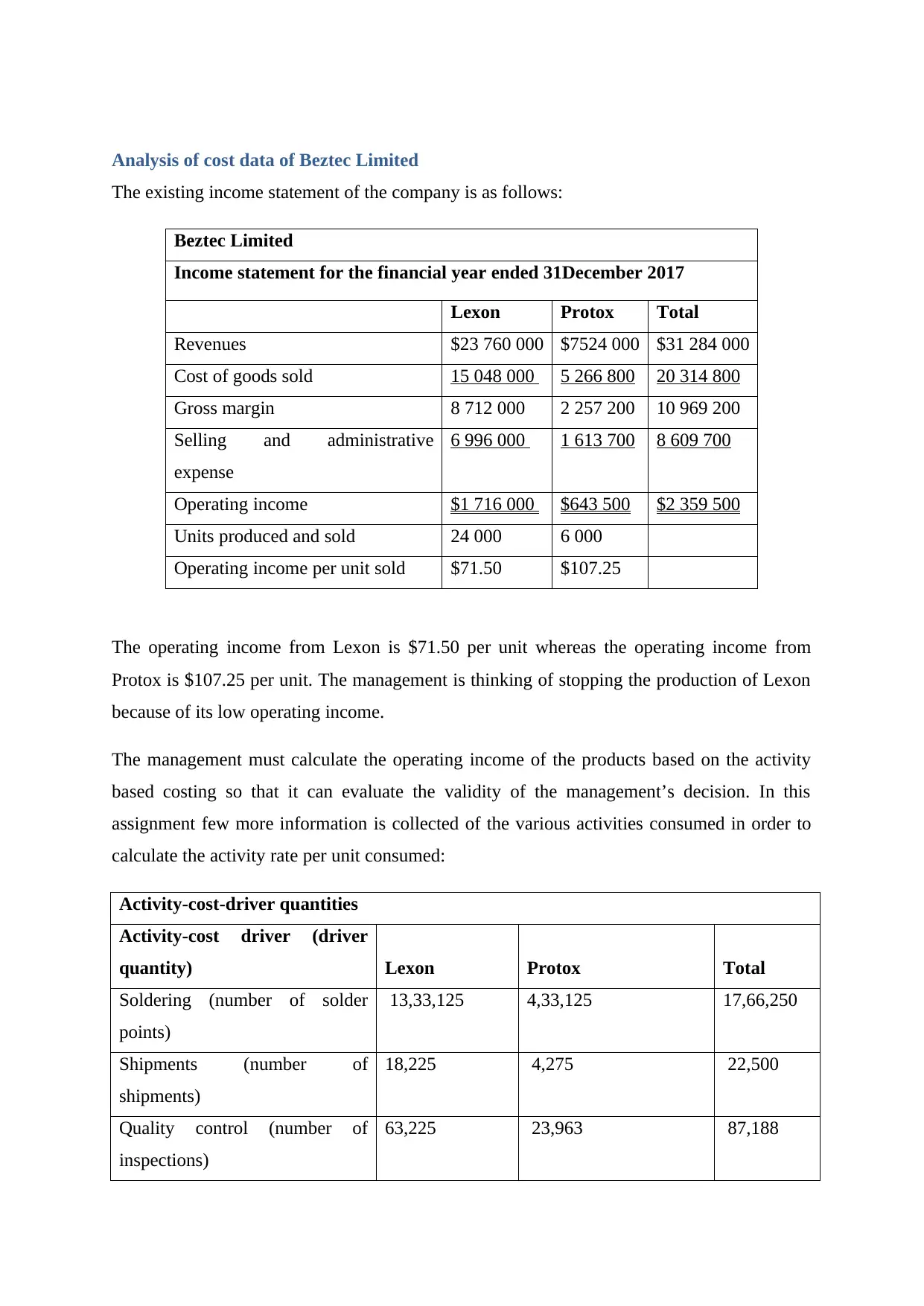
Analysis of cost data of Beztec Limited
The existing income statement of the company is as follows:
Beztec Limited
Income statement for the financial year ended 31December 2017
Lexon Protox Total
Revenues $23 760 000 $7524 000 $31 284 000
Cost of goods sold 15 048 000 5 266 800 20 314 800
Gross margin 8 712 000 2 257 200 10 969 200
Selling and administrative
expense
6 996 000 1 613 700 8 609 700
Operating income $1 716 000 $643 500 $2 359 500
Units produced and sold 24 000 6 000
Operating income per unit sold $71.50 $107.25
The operating income from Lexon is $71.50 per unit whereas the operating income from
Protox is $107.25 per unit. The management is thinking of stopping the production of Lexon
because of its low operating income.
The management must calculate the operating income of the products based on the activity
based costing so that it can evaluate the validity of the management’s decision. In this
assignment few more information is collected of the various activities consumed in order to
calculate the activity rate per unit consumed:
Activity-cost-driver quantities
Activity-cost driver (driver
quantity) Lexon Protox Total
Soldering (number of solder
points)
13,33,125 4,33,125 17,66,250
Shipments (number of
shipments)
18,225 4,275 22,500
Quality control (number of
inspections)
63,225 23,963 87,188
The existing income statement of the company is as follows:
Beztec Limited
Income statement for the financial year ended 31December 2017
Lexon Protox Total
Revenues $23 760 000 $7524 000 $31 284 000
Cost of goods sold 15 048 000 5 266 800 20 314 800
Gross margin 8 712 000 2 257 200 10 969 200
Selling and administrative
expense
6 996 000 1 613 700 8 609 700
Operating income $1 716 000 $643 500 $2 359 500
Units produced and sold 24 000 6 000
Operating income per unit sold $71.50 $107.25
The operating income from Lexon is $71.50 per unit whereas the operating income from
Protox is $107.25 per unit. The management is thinking of stopping the production of Lexon
because of its low operating income.
The management must calculate the operating income of the products based on the activity
based costing so that it can evaluate the validity of the management’s decision. In this
assignment few more information is collected of the various activities consumed in order to
calculate the activity rate per unit consumed:
Activity-cost-driver quantities
Activity-cost driver (driver
quantity) Lexon Protox Total
Soldering (number of solder
points)
13,33,125 4,33,125 17,66,250
Shipments (number of
shipments)
18,225 4,275 22,500
Quality control (number of
inspections)
63,225 23,963 87,188
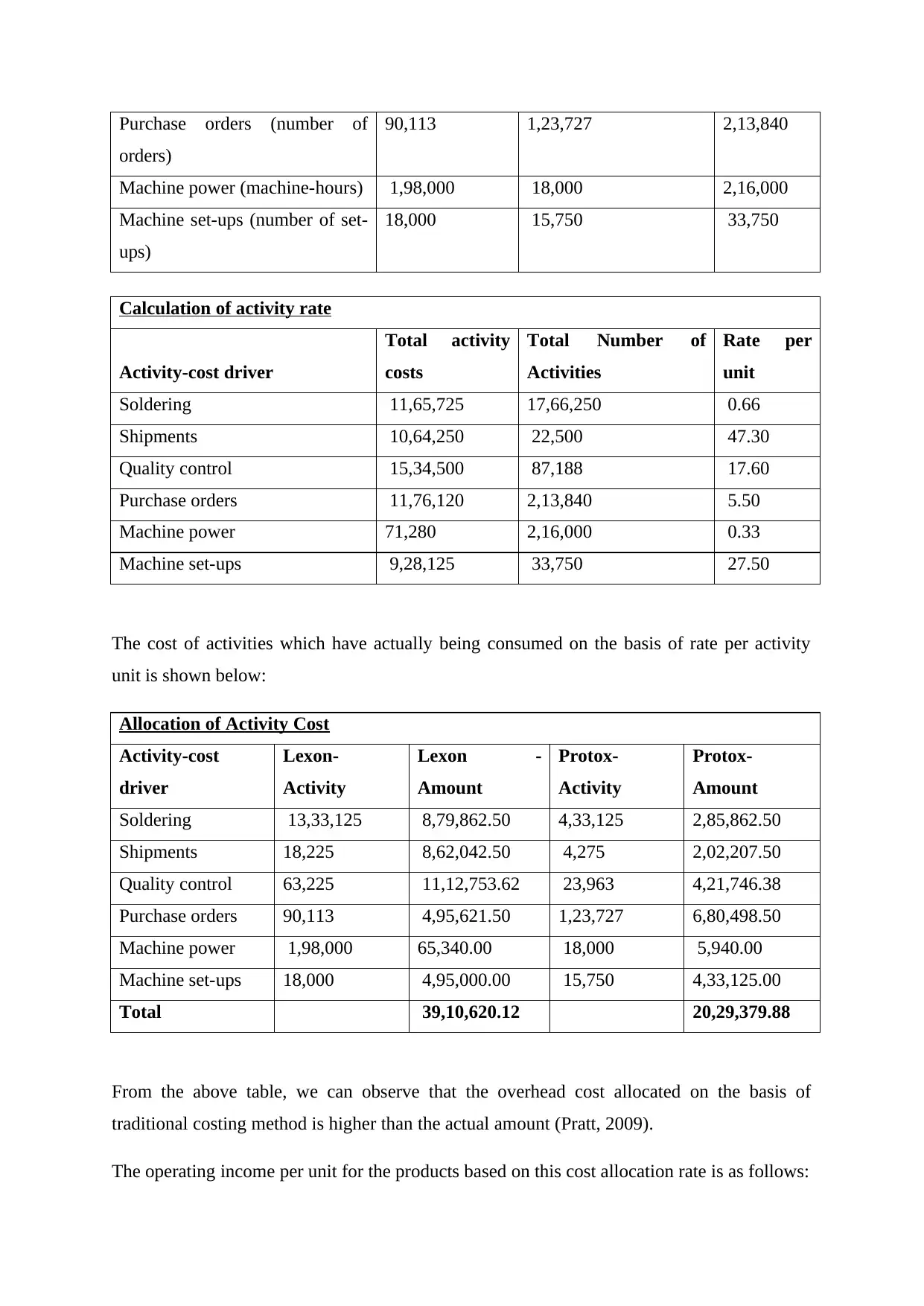
Purchase orders (number of
orders)
90,113 1,23,727 2,13,840
Machine power (machine-hours) 1,98,000 18,000 2,16,000
Machine set-ups (number of set-
ups)
18,000 15,750 33,750
Calculation of activity rate
Activity-cost driver
Total activity
costs
Total Number of
Activities
Rate per
unit
Soldering 11,65,725 17,66,250 0.66
Shipments 10,64,250 22,500 47.30
Quality control 15,34,500 87,188 17.60
Purchase orders 11,76,120 2,13,840 5.50
Machine power 71,280 2,16,000 0.33
Machine set-ups 9,28,125 33,750 27.50
The cost of activities which have actually being consumed on the basis of rate per activity
unit is shown below:
Allocation of Activity Cost
Activity-cost
driver
Lexon-
Activity
Lexon -
Amount
Protox-
Activity
Protox-
Amount
Soldering 13,33,125 8,79,862.50 4,33,125 2,85,862.50
Shipments 18,225 8,62,042.50 4,275 2,02,207.50
Quality control 63,225 11,12,753.62 23,963 4,21,746.38
Purchase orders 90,113 4,95,621.50 1,23,727 6,80,498.50
Machine power 1,98,000 65,340.00 18,000 5,940.00
Machine set-ups 18,000 4,95,000.00 15,750 4,33,125.00
Total 39,10,620.12 20,29,379.88
From the above table, we can observe that the overhead cost allocated on the basis of
traditional costing method is higher than the actual amount (Pratt, 2009).
The operating income per unit for the products based on this cost allocation rate is as follows:
orders)
90,113 1,23,727 2,13,840
Machine power (machine-hours) 1,98,000 18,000 2,16,000
Machine set-ups (number of set-
ups)
18,000 15,750 33,750
Calculation of activity rate
Activity-cost driver
Total activity
costs
Total Number of
Activities
Rate per
unit
Soldering 11,65,725 17,66,250 0.66
Shipments 10,64,250 22,500 47.30
Quality control 15,34,500 87,188 17.60
Purchase orders 11,76,120 2,13,840 5.50
Machine power 71,280 2,16,000 0.33
Machine set-ups 9,28,125 33,750 27.50
The cost of activities which have actually being consumed on the basis of rate per activity
unit is shown below:
Allocation of Activity Cost
Activity-cost
driver
Lexon-
Activity
Lexon -
Amount
Protox-
Activity
Protox-
Amount
Soldering 13,33,125 8,79,862.50 4,33,125 2,85,862.50
Shipments 18,225 8,62,042.50 4,275 2,02,207.50
Quality control 63,225 11,12,753.62 23,963 4,21,746.38
Purchase orders 90,113 4,95,621.50 1,23,727 6,80,498.50
Machine power 1,98,000 65,340.00 18,000 5,940.00
Machine set-ups 18,000 4,95,000.00 15,750 4,33,125.00
Total 39,10,620.12 20,29,379.88
From the above table, we can observe that the overhead cost allocated on the basis of
traditional costing method is higher than the actual amount (Pratt, 2009).
The operating income per unit for the products based on this cost allocation rate is as follows:
⊘ This is a preview!⊘
Do you want full access?
Subscribe today to unlock all pages.

Trusted by 1+ million students worldwide
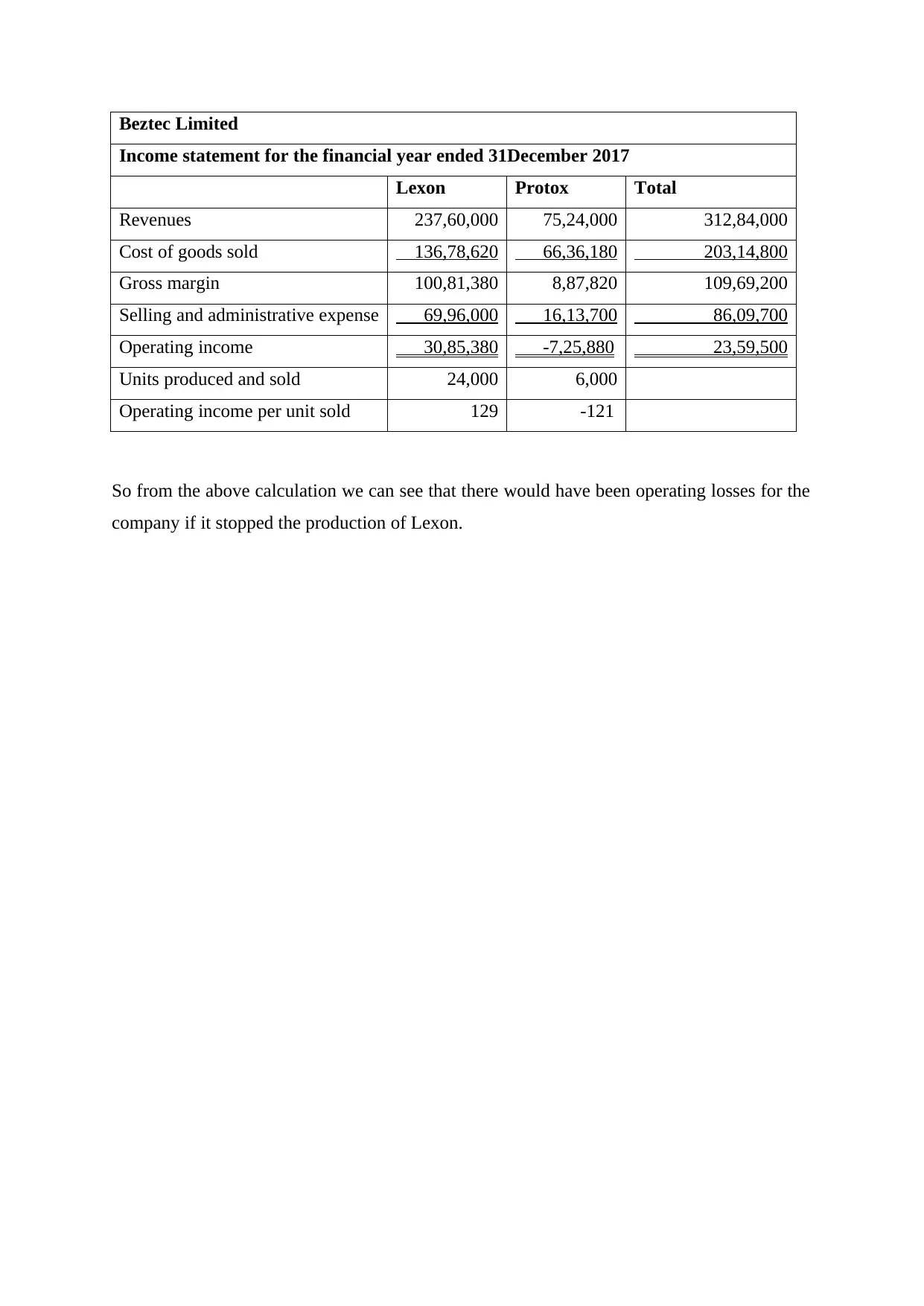
Beztec Limited
Income statement for the financial year ended 31December 2017
Lexon Protox Total
Revenues 237,60,000 75,24,000 312,84,000
Cost of goods sold 136,78,620 66,36,180 203,14,800
Gross margin 100,81,380 8,87,820 109,69,200
Selling and administrative expense 69,96,000 16,13,700 86,09,700
Operating income 30,85,380 -7,25,880 23,59,500
Units produced and sold 24,000 6,000
Operating income per unit sold 129 -121
So from the above calculation we can see that there would have been operating losses for the
company if it stopped the production of Lexon.
Income statement for the financial year ended 31December 2017
Lexon Protox Total
Revenues 237,60,000 75,24,000 312,84,000
Cost of goods sold 136,78,620 66,36,180 203,14,800
Gross margin 100,81,380 8,87,820 109,69,200
Selling and administrative expense 69,96,000 16,13,700 86,09,700
Operating income 30,85,380 -7,25,880 23,59,500
Units produced and sold 24,000 6,000
Operating income per unit sold 129 -121
So from the above calculation we can see that there would have been operating losses for the
company if it stopped the production of Lexon.
Paraphrase This Document
Need a fresh take? Get an instant paraphrase of this document with our AI Paraphraser
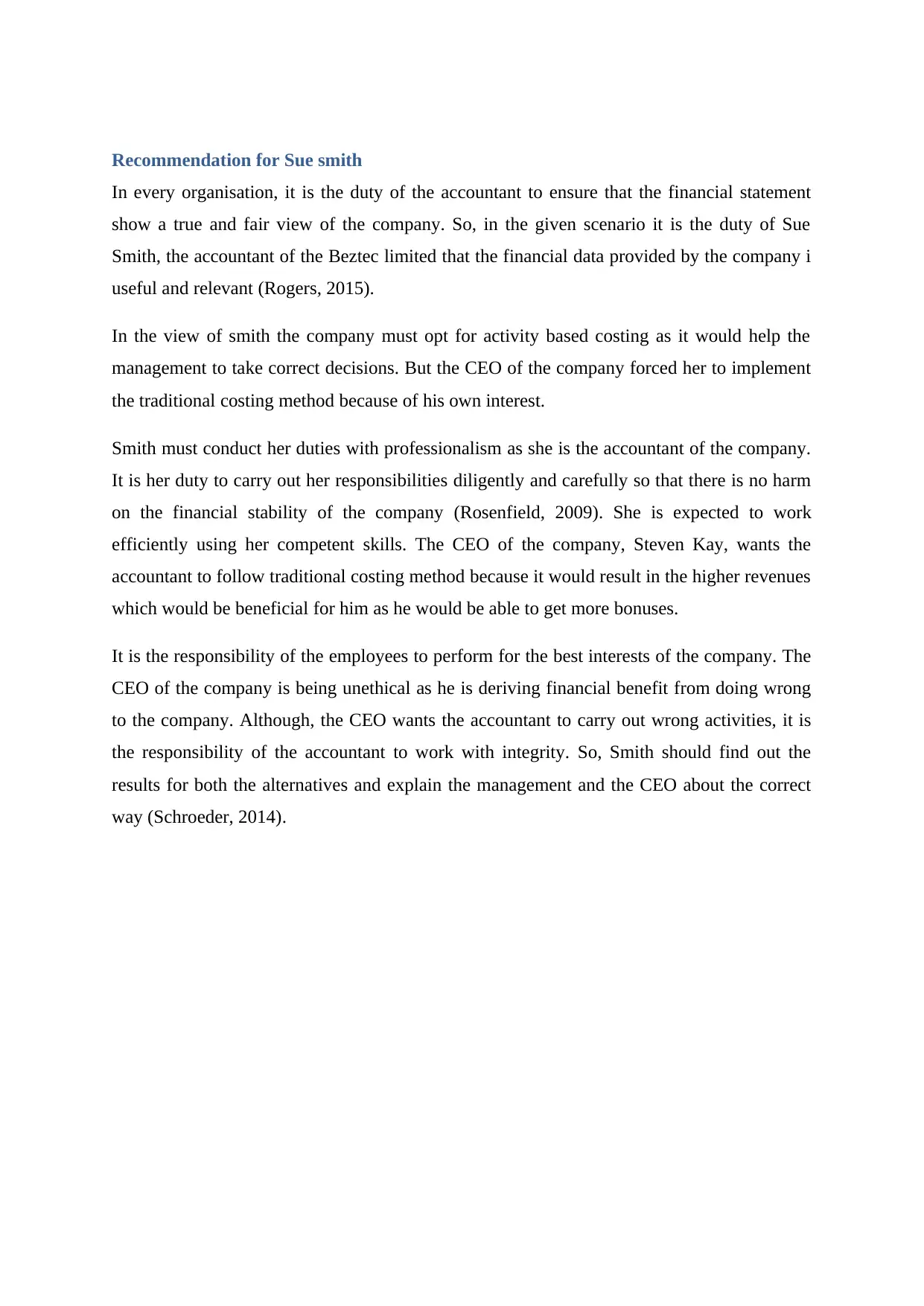
Recommendation for Sue smith
In every organisation, it is the duty of the accountant to ensure that the financial statement
show a true and fair view of the company. So, in the given scenario it is the duty of Sue
Smith, the accountant of the Beztec limited that the financial data provided by the company i
useful and relevant (Rogers, 2015).
In the view of smith the company must opt for activity based costing as it would help the
management to take correct decisions. But the CEO of the company forced her to implement
the traditional costing method because of his own interest.
Smith must conduct her duties with professionalism as she is the accountant of the company.
It is her duty to carry out her responsibilities diligently and carefully so that there is no harm
on the financial stability of the company (Rosenfield, 2009). She is expected to work
efficiently using her competent skills. The CEO of the company, Steven Kay, wants the
accountant to follow traditional costing method because it would result in the higher revenues
which would be beneficial for him as he would be able to get more bonuses.
It is the responsibility of the employees to perform for the best interests of the company. The
CEO of the company is being unethical as he is deriving financial benefit from doing wrong
to the company. Although, the CEO wants the accountant to carry out wrong activities, it is
the responsibility of the accountant to work with integrity. So, Smith should find out the
results for both the alternatives and explain the management and the CEO about the correct
way (Schroeder, 2014).
In every organisation, it is the duty of the accountant to ensure that the financial statement
show a true and fair view of the company. So, in the given scenario it is the duty of Sue
Smith, the accountant of the Beztec limited that the financial data provided by the company i
useful and relevant (Rogers, 2015).
In the view of smith the company must opt for activity based costing as it would help the
management to take correct decisions. But the CEO of the company forced her to implement
the traditional costing method because of his own interest.
Smith must conduct her duties with professionalism as she is the accountant of the company.
It is her duty to carry out her responsibilities diligently and carefully so that there is no harm
on the financial stability of the company (Rosenfield, 2009). She is expected to work
efficiently using her competent skills. The CEO of the company, Steven Kay, wants the
accountant to follow traditional costing method because it would result in the higher revenues
which would be beneficial for him as he would be able to get more bonuses.
It is the responsibility of the employees to perform for the best interests of the company. The
CEO of the company is being unethical as he is deriving financial benefit from doing wrong
to the company. Although, the CEO wants the accountant to carry out wrong activities, it is
the responsibility of the accountant to work with integrity. So, Smith should find out the
results for both the alternatives and explain the management and the CEO about the correct
way (Schroeder, 2014).
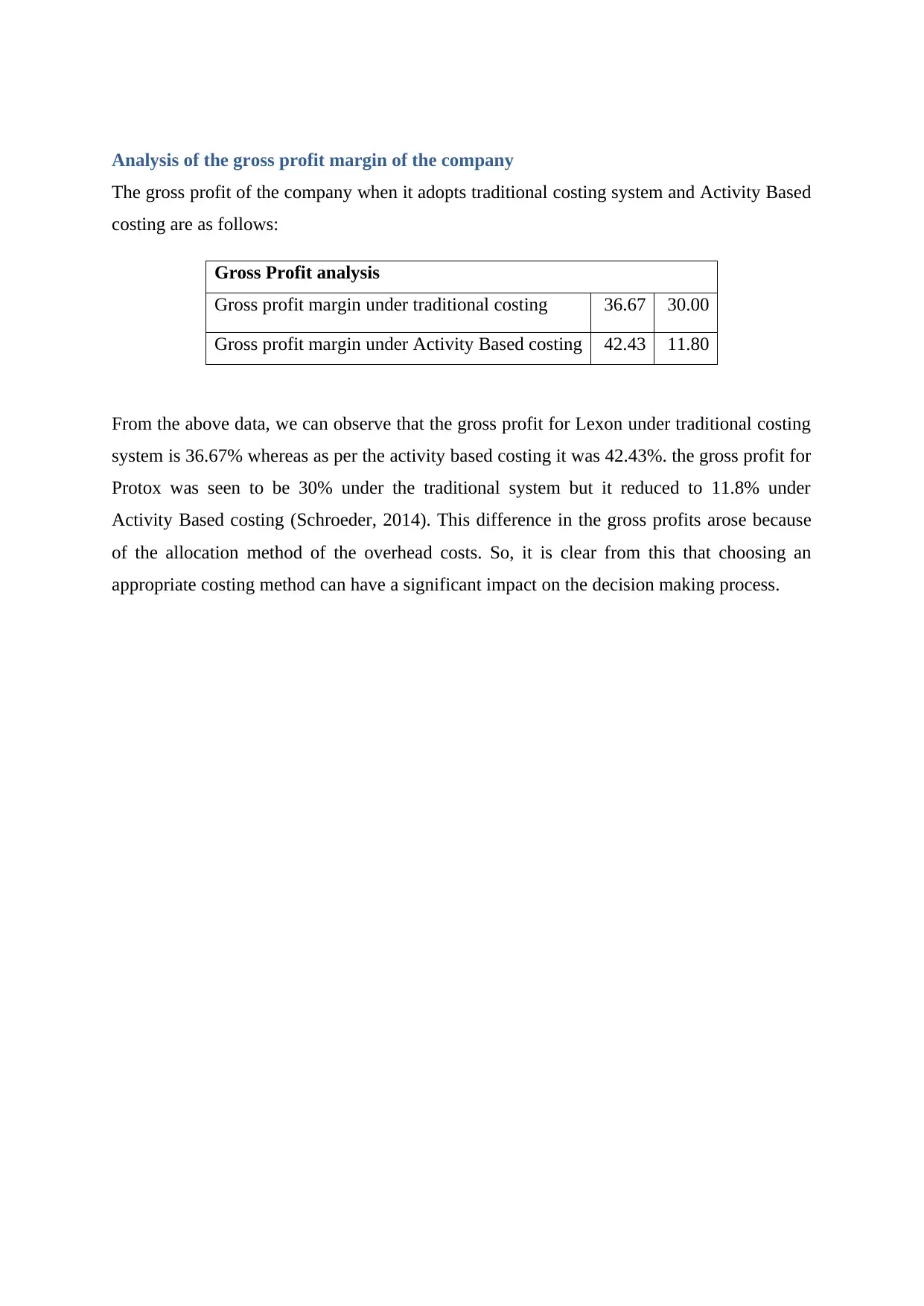
Analysis of the gross profit margin of the company
The gross profit of the company when it adopts traditional costing system and Activity Based
costing are as follows:
Gross Profit analysis
Gross profit margin under traditional costing 36.67 30.00
Gross profit margin under Activity Based costing 42.43 11.80
From the above data, we can observe that the gross profit for Lexon under traditional costing
system is 36.67% whereas as per the activity based costing it was 42.43%. the gross profit for
Protox was seen to be 30% under the traditional system but it reduced to 11.8% under
Activity Based costing (Schroeder, 2014). This difference in the gross profits arose because
of the allocation method of the overhead costs. So, it is clear from this that choosing an
appropriate costing method can have a significant impact on the decision making process.
The gross profit of the company when it adopts traditional costing system and Activity Based
costing are as follows:
Gross Profit analysis
Gross profit margin under traditional costing 36.67 30.00
Gross profit margin under Activity Based costing 42.43 11.80
From the above data, we can observe that the gross profit for Lexon under traditional costing
system is 36.67% whereas as per the activity based costing it was 42.43%. the gross profit for
Protox was seen to be 30% under the traditional system but it reduced to 11.8% under
Activity Based costing (Schroeder, 2014). This difference in the gross profits arose because
of the allocation method of the overhead costs. So, it is clear from this that choosing an
appropriate costing method can have a significant impact on the decision making process.
⊘ This is a preview!⊘
Do you want full access?
Subscribe today to unlock all pages.

Trusted by 1+ million students worldwide
1 out of 15
Related Documents
Your All-in-One AI-Powered Toolkit for Academic Success.
+13062052269
info@desklib.com
Available 24*7 on WhatsApp / Email
![[object Object]](/_next/static/media/star-bottom.7253800d.svg)
Unlock your academic potential
Copyright © 2020–2025 A2Z Services. All Rights Reserved. Developed and managed by ZUCOL.





